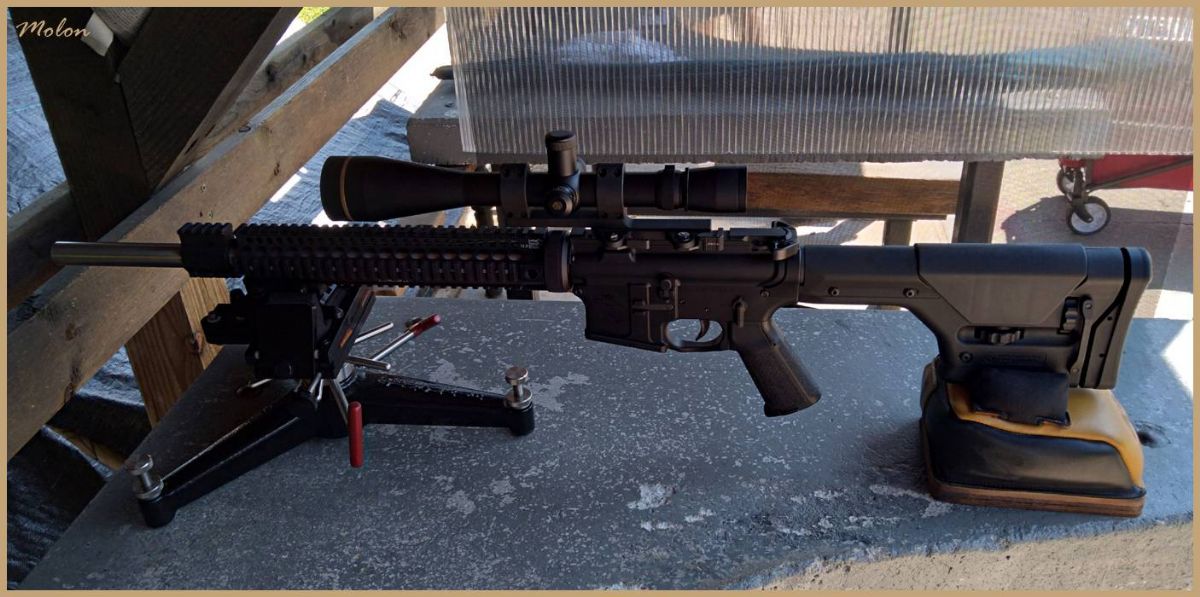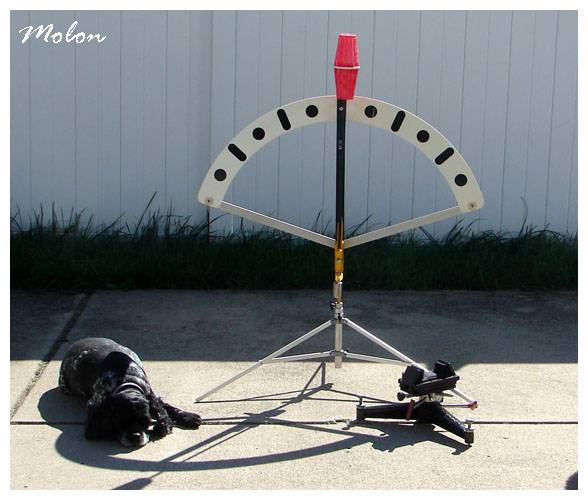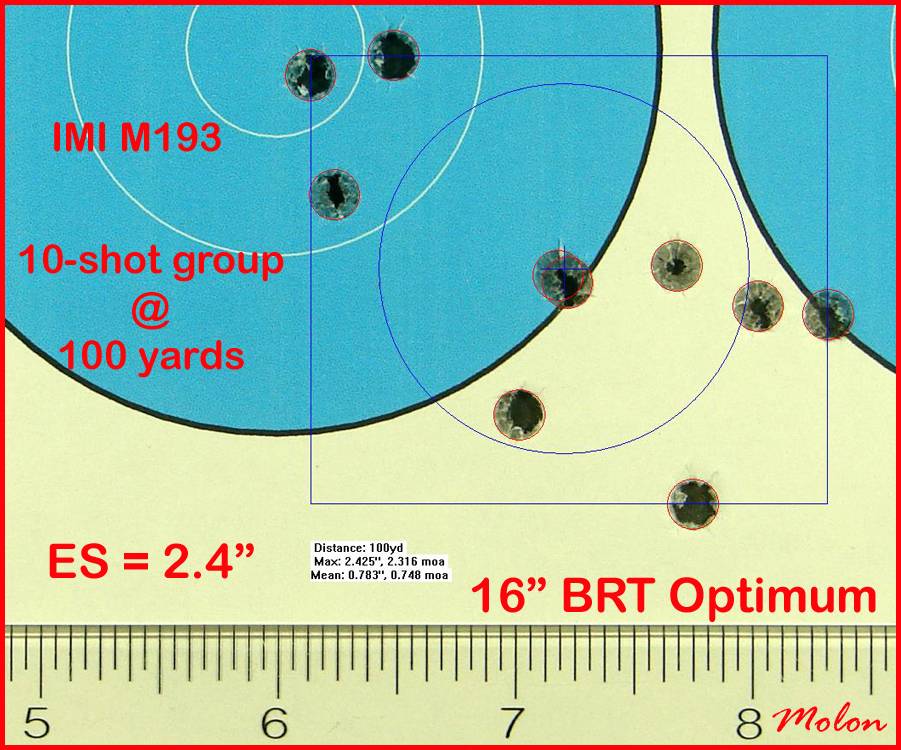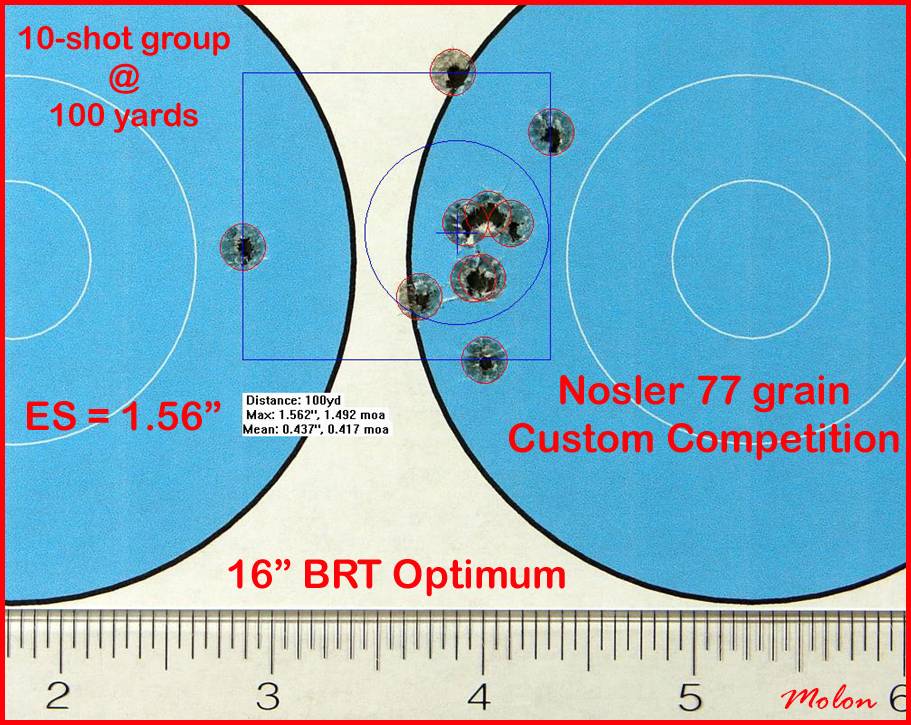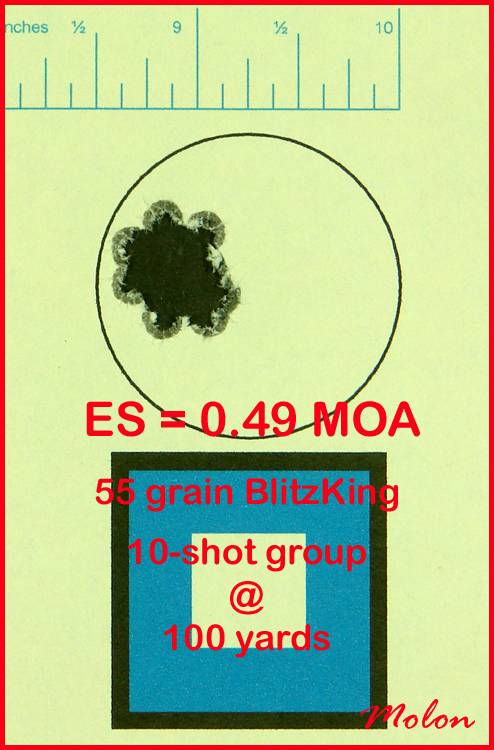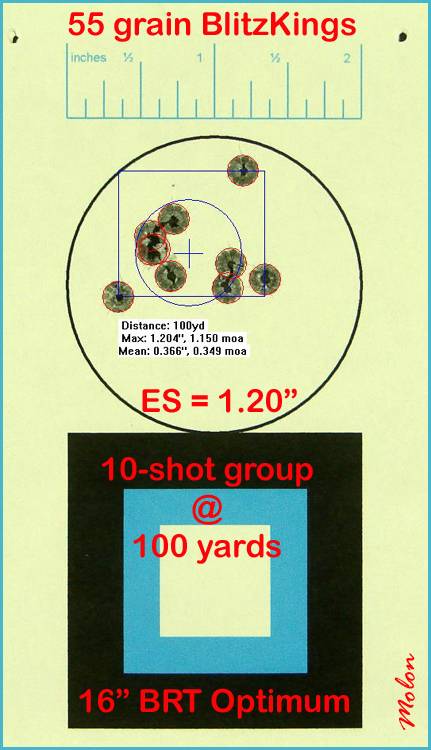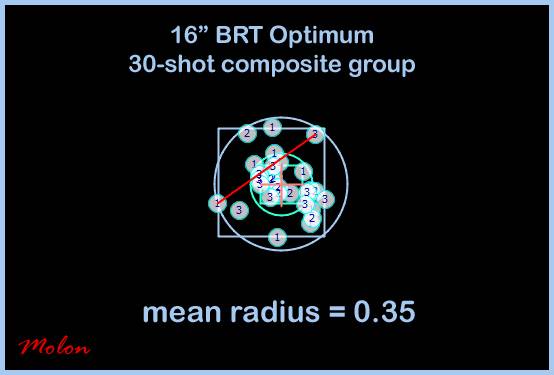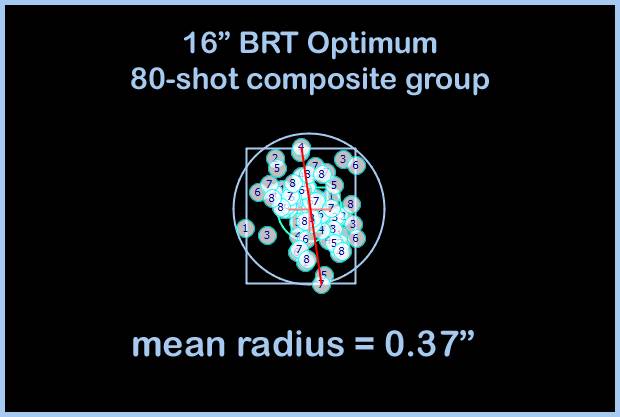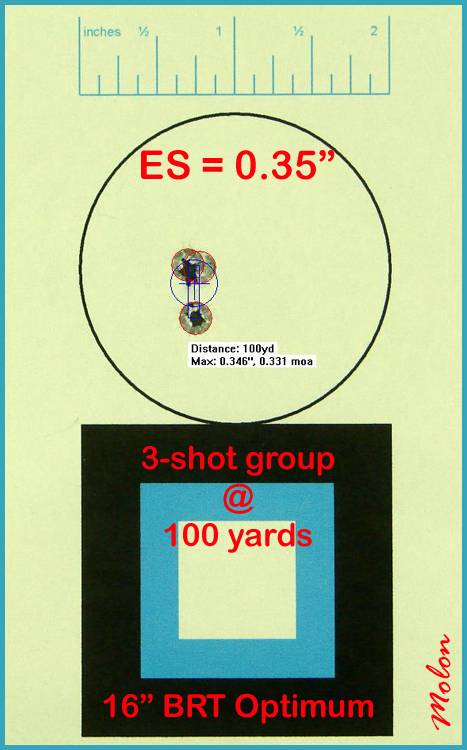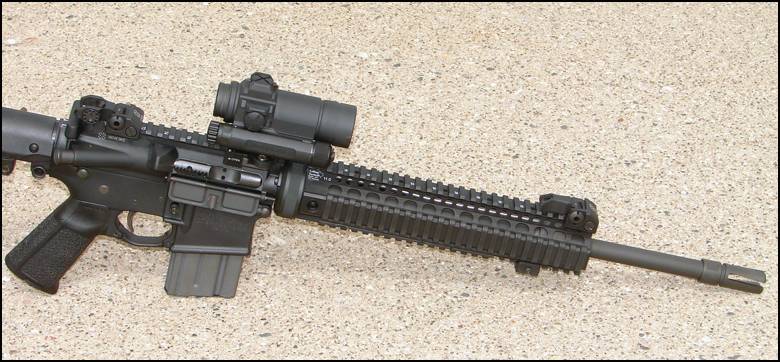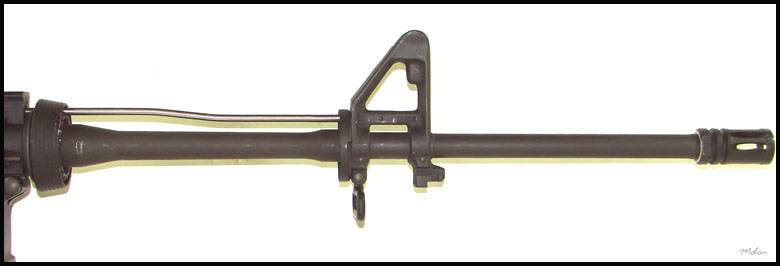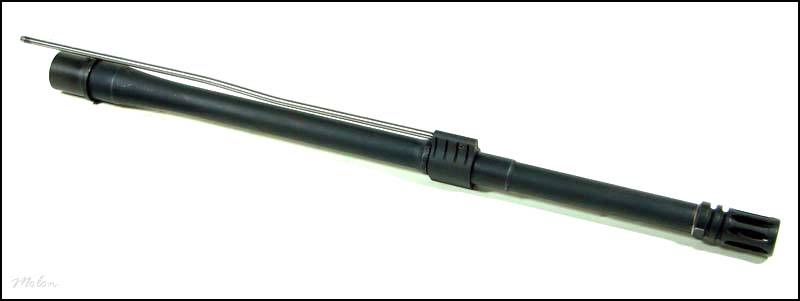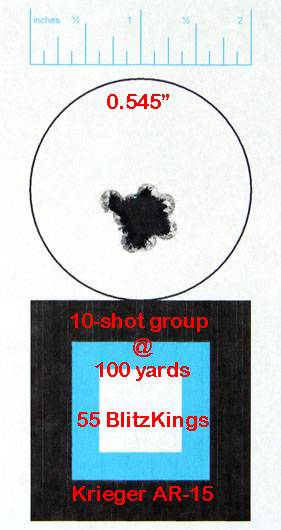Black River Tactical 16” Cold Hammer Forged Optimum Barrel Accuracy Evaluation

Black River Tactical has sold at least three differently constructed versions of their 16” Optimum barrel. This article showcases the cold hammer forged version that’s constructed of 4150 CrMoV steel. This barrel has a chrome-lined bore and chamber and a manganese phosphate exterior finish. The BRT CHF Optimum barrels have a 1:7” twist and a 5.56mm NATO chamber. The barrel has laser engraved markings that read:
BRT 5.56 1/7 HF CL-22J

I used a Colt reference bolt to check the headspace of the chamber on this Optimum barrel. The bolt closed on a 1.4646” headspace gauge. The bolt did not close on a 1.4696” gauge. Fired brass had a measured nominal headspace of 1.469”. A dummy round that meets SAAMI specifications easily seated completely into the chamber and dropped easily out of the chamber.
A 15” x 0.217” straightness gauge passed smoothly through the bore of the barrel. The land-to-land diameter at the muzzle gauged at 0.2191”.
The barrel extension has M4-type feed-ramps, although the extension is not marked as such like Colt barrels.
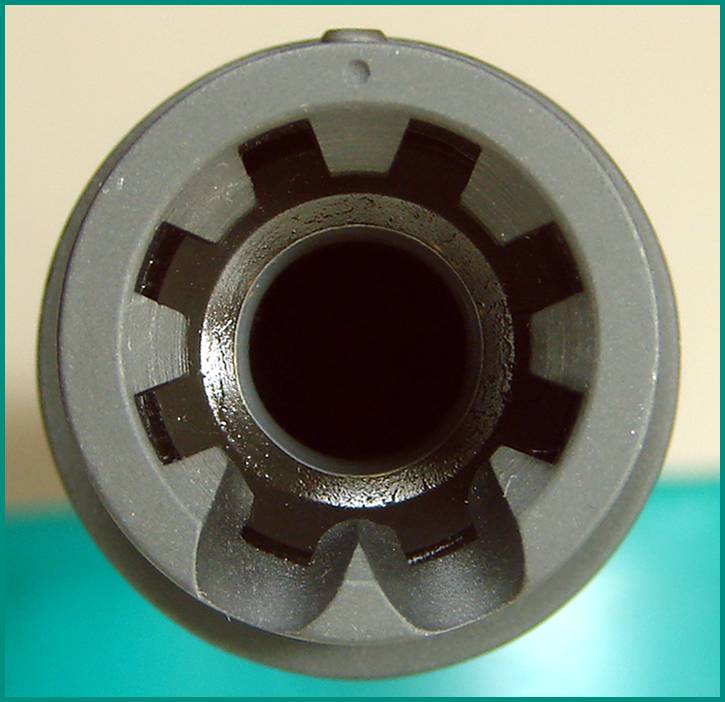
The muzzle has a slightly recessed crown. The barrel does not have a recess cut between the base of the muzzle threads and the shoulder of the barrel.


The following picture shows a borescope image of a CHF Hodge Defense barrel, which is manufactured by Fabrique Nationale. There’s nothing unusual about the appearance of the bore of this barrel as it has the typical bright pewter-ish appearance of a chrome-lined AR-15 barrel.
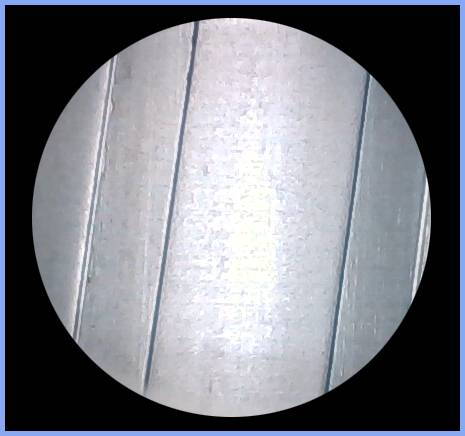
The next borescope view shows the throat of the BRT CHF Optimum barrel. Both the chamber and the bore of this barrel have a dark grey “coated” appearance to them. BRT claims that these barrels are “finished with an advanced hard chrome lining process”. The owner of BRT has refused to answer questions about any of this.
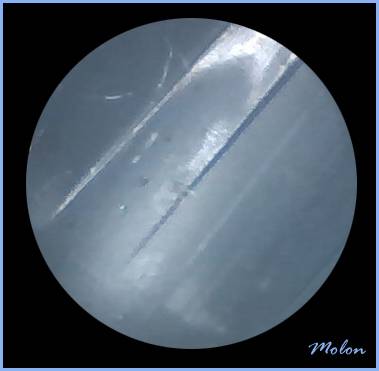
The 16” BRT Optimum barrel weighs approximately 1 pound, 11 ounces. For comparison, the 16” government profile barrel found on the Colt 6920 weighs 1 pound, 12 ounces.
The Optimum barrel has a pseudo-tapered profile. The barrel tapers from just forward of the chamber to just aft of the gas block journal, but unfortunately, at that point the barrel diameter swells for a 0.750” gas block journal. The shoulder for the handguard end-cap has a diameter of approximately 0.845”. The picture below compares the gas block journal of the Optimum barrel to the 0.625” gas block journal of a 16” Criterion CORE barrel (which weighs 1 pound, 12 ounces).

On the positive side, the gas block journal of the Optimum barrel mic’d at 0.7497”. The bore of the BRT low profile gas block that I used for this build had a gauged diameter of 0.7499” creating an excellent fit between the gas block and gas block journal. Another feature of the BRT low profile gas block is the diameter of the gas tube channel. It gauged at 0.1801” giving it a good fit with the 0.1798” BRT gas tube. These attributes contribute to an efficient gas system.
With a new AR-15, it's not at all uncommon to see a fair amount of fouling coming from the juncture of the gas tube and gas block due to gas leakage at this location. The carbon fouling will usually seal this leakage after several hundred rounds have been fired. Due to the close fit of the BRT components, there was hardly any fouling noted at this location.
The BRT gas block . . .

After 300 rounds had been fired through the barrel . . .

The gas block journal on the Optimum barrel is intended for use with low profile gas blocks only. It’s approximately 1” in length, so you won’t be able to use an A2 front sight base with this barrel. The gas block journal of the Optimum barrel comes with a single dimple contralateral to the gas port for positioning and fastening the gas block.
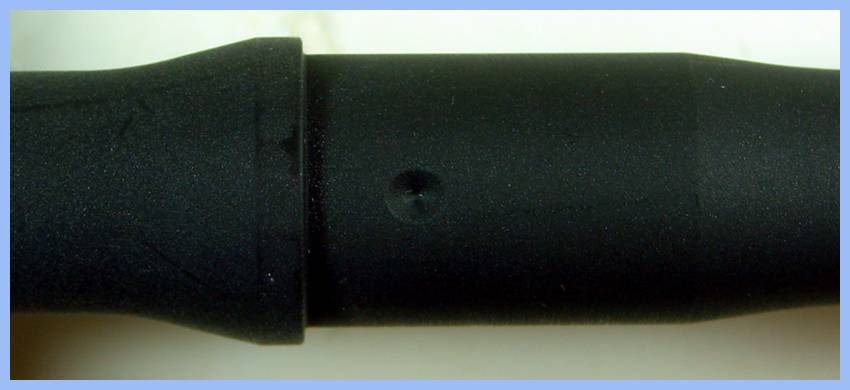
The most notable feature of the 16” CHF Optimum barrel is its intermediate-type gas system; meaning the length of the gas system is in between that of a standard mid-length gas system and a standard length rifle gas system.

BRT has referred to their intermediate-type gas system as both an extended length system and an intermediate length system in their description of this barrel. For the ease of discussion for the rest of the article I’ll be referring to the BRT gas system on this barrel as an intermediate length system. Be aware that there are multiple intermediate-type gas systems on the market with varying lengths. As an example, the BRT intermediate gas system is slightly shorter than the Noveske intermediate gas system found on Noveske’s 18” SPR barrels.

The next two pictures will give you an idea of how the BRT intermediate gas system compares in length to other common AR-15 gas system lengths.


The next picture demonstrates the dwell time (technically dwell length) of the 16” BRT Optimum intermediate gas system compared to other common gas systems found on the AR-15.

BRT refuses to provide prospective customers with the diameters of the gas ports on the CHF Optimum barrels so that they might make informed purchasing decisions. The diameter of the gas port on this 16” Optimum barrel gauged at 0.081”.
BRT recommends using the A5H0 buffer for shooting unsuppressed with this barrel. I’ve found the A5H1 to be more suitable for shooting with a mix of 5.56mm loads and quality 223 Remington loads
I installed the BRT Optimum barrel in a Bravo Company upper receiver. For those of you who might not be familiar with the BCM upper receivers, they are intentionally made under-sized in the section of the bore that accepts the barrel extension. This requires a thermal fitting with the barrel extension and creates such a tight fit that it’s not possible to pull the components apart by hand and eliminates any play between the barrel extension and upper receiver.
The Optimum barrel was free-floated in a Bravo Company 13” MCMR M-LOK handguard with a V Seven titanium barrel nut. I rounded out the upper receiver group with a BCM Mod 4B charging handle, a Forward Controls Design flash hider and a Geissele bolt carrier group.
On a side note, the Geissele bolt carrier group has some interesting dimensions. The diameter of the bolt tail fails to meet the US mil-spec, but in a good way. The mil-spec for the bolt tail calls for a diameter of 0.2503” plus or minus 0.0002”. The diameter of the Geissle bolt tail is 0.2507”. This bolt tail forms an exemplary gas seal with the bolt tail channel inside the bolt carrier (0.2514” on the Geissele carrier) contributing to the efficiency of the gas system.


continued in the next post . . . .

Black River Tactical has sold at least three differently constructed versions of their 16” Optimum barrel. This article showcases the cold hammer forged version that’s constructed of 4150 CrMoV steel. This barrel has a chrome-lined bore and chamber and a manganese phosphate exterior finish. The BRT CHF Optimum barrels have a 1:7” twist and a 5.56mm NATO chamber. The barrel has laser engraved markings that read:
BRT 5.56 1/7 HF CL-22J

I used a Colt reference bolt to check the headspace of the chamber on this Optimum barrel. The bolt closed on a 1.4646” headspace gauge. The bolt did not close on a 1.4696” gauge. Fired brass had a measured nominal headspace of 1.469”. A dummy round that meets SAAMI specifications easily seated completely into the chamber and dropped easily out of the chamber.
A 15” x 0.217” straightness gauge passed smoothly through the bore of the barrel. The land-to-land diameter at the muzzle gauged at 0.2191”.
The barrel extension has M4-type feed-ramps, although the extension is not marked as such like Colt barrels.

The muzzle has a slightly recessed crown. The barrel does not have a recess cut between the base of the muzzle threads and the shoulder of the barrel.


The following picture shows a borescope image of a CHF Hodge Defense barrel, which is manufactured by Fabrique Nationale. There’s nothing unusual about the appearance of the bore of this barrel as it has the typical bright pewter-ish appearance of a chrome-lined AR-15 barrel.

The next borescope view shows the throat of the BRT CHF Optimum barrel. Both the chamber and the bore of this barrel have a dark grey “coated” appearance to them. BRT claims that these barrels are “finished with an advanced hard chrome lining process”. The owner of BRT has refused to answer questions about any of this.

The 16” BRT Optimum barrel weighs approximately 1 pound, 11 ounces. For comparison, the 16” government profile barrel found on the Colt 6920 weighs 1 pound, 12 ounces.
The Optimum barrel has a pseudo-tapered profile. The barrel tapers from just forward of the chamber to just aft of the gas block journal, but unfortunately, at that point the barrel diameter swells for a 0.750” gas block journal. The shoulder for the handguard end-cap has a diameter of approximately 0.845”. The picture below compares the gas block journal of the Optimum barrel to the 0.625” gas block journal of a 16” Criterion CORE barrel (which weighs 1 pound, 12 ounces).

On the positive side, the gas block journal of the Optimum barrel mic’d at 0.7497”. The bore of the BRT low profile gas block that I used for this build had a gauged diameter of 0.7499” creating an excellent fit between the gas block and gas block journal. Another feature of the BRT low profile gas block is the diameter of the gas tube channel. It gauged at 0.1801” giving it a good fit with the 0.1798” BRT gas tube. These attributes contribute to an efficient gas system.
With a new AR-15, it's not at all uncommon to see a fair amount of fouling coming from the juncture of the gas tube and gas block due to gas leakage at this location. The carbon fouling will usually seal this leakage after several hundred rounds have been fired. Due to the close fit of the BRT components, there was hardly any fouling noted at this location.
The BRT gas block . . .

After 300 rounds had been fired through the barrel . . .

The gas block journal on the Optimum barrel is intended for use with low profile gas blocks only. It’s approximately 1” in length, so you won’t be able to use an A2 front sight base with this barrel. The gas block journal of the Optimum barrel comes with a single dimple contralateral to the gas port for positioning and fastening the gas block.

The most notable feature of the 16” CHF Optimum barrel is its intermediate-type gas system; meaning the length of the gas system is in between that of a standard mid-length gas system and a standard length rifle gas system.

BRT has referred to their intermediate-type gas system as both an extended length system and an intermediate length system in their description of this barrel. For the ease of discussion for the rest of the article I’ll be referring to the BRT gas system on this barrel as an intermediate length system. Be aware that there are multiple intermediate-type gas systems on the market with varying lengths. As an example, the BRT intermediate gas system is slightly shorter than the Noveske intermediate gas system found on Noveske’s 18” SPR barrels.

The next two pictures will give you an idea of how the BRT intermediate gas system compares in length to other common AR-15 gas system lengths.


The next picture demonstrates the dwell time (technically dwell length) of the 16” BRT Optimum intermediate gas system compared to other common gas systems found on the AR-15.

BRT refuses to provide prospective customers with the diameters of the gas ports on the CHF Optimum barrels so that they might make informed purchasing decisions. The diameter of the gas port on this 16” Optimum barrel gauged at 0.081”.
BRT recommends using the A5H0 buffer for shooting unsuppressed with this barrel. I’ve found the A5H1 to be more suitable for shooting with a mix of 5.56mm loads and quality 223 Remington loads
I installed the BRT Optimum barrel in a Bravo Company upper receiver. For those of you who might not be familiar with the BCM upper receivers, they are intentionally made under-sized in the section of the bore that accepts the barrel extension. This requires a thermal fitting with the barrel extension and creates such a tight fit that it’s not possible to pull the components apart by hand and eliminates any play between the barrel extension and upper receiver.
The Optimum barrel was free-floated in a Bravo Company 13” MCMR M-LOK handguard with a V Seven titanium barrel nut. I rounded out the upper receiver group with a BCM Mod 4B charging handle, a Forward Controls Design flash hider and a Geissele bolt carrier group.
On a side note, the Geissele bolt carrier group has some interesting dimensions. The diameter of the bolt tail fails to meet the US mil-spec, but in a good way. The mil-spec for the bolt tail calls for a diameter of 0.2503” plus or minus 0.0002”. The diameter of the Geissle bolt tail is 0.2507”. This bolt tail forms an exemplary gas seal with the bolt tail channel inside the bolt carrier (0.2514” on the Geissele carrier) contributing to the efficiency of the gas system.


continued in the next post . . . .
Last edited:

